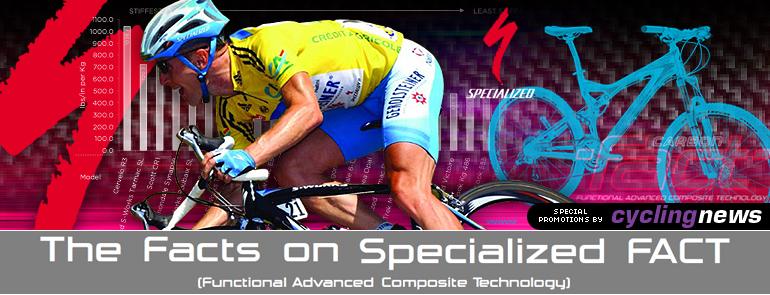Part 2: Understanding The Ride
Acute Rider Insight is the First Step in any FACT Chassis or Component
(Back to Part 1: All About FACT)
With any Specialized bike or piece of equipment — regardless of price or intended rider experience — the materials Specialize uses, the design it selects, and the manufacturing process it employs are all chosen in careful consideration of one another.
This integration of development ensures a balanced and integrated piece of equipment, one that has been designed and manufactured for its intended application. Different types of riding demand different attributes from a chassis or component. Once the design and engineering team understand the experience that a particular bike is being made to fulfill, Specialize prioritizes the following attributes depending on the specific product that is being developed:
- Lateral and Torsional Rigidity: Excellent bottom bracket stiffness and torsional rigidity enhance efficiency, responsiveness and handling.
- Appropriate Strength: Different types of riding have different strength requirements. FACT takes these into account and creates strength targets that surpass industry standards to ensure that the frame or component is more than up to the task.
- Vertical Compliance: FACT frames and forks feature superior vertical compliance — fatigue-fighting compliance that's measurable.
- Weight: Less is obviously more, but only if safety and ride quality standards are satisfied.
The development of any FACT chassis or component always starts with the demands of the experience that it is being designed for, then moves into a wholly integrated process involving: design and engineering, selection and manipulation of appropriate materials, selection of a Manufacturing Method: At Specialized we use only Az1 Sequentially Cured Monocoque and Triple Monocoque (more on that later), Testing and revision of the Lay-up Schedule Development (LSD), performance testing in both our lab and the field. Once an original version of a chassis or component is in the field, we continue to test, with each round of testing resulting in further fine-tuning and revision of the product. This testing loop continues until the optimal result has been achieved.
Fact Design And Engineering
A collaborative process that results in frames and components that look as good as they ride.
Beyond just visual style, the shape of a carbon frame or component has a huge impact on how it will perform. After concept drawings are produced by the industrial design team, the engineered shape of any carbon chassis or component is developed by the engineering team using a variety of digital design tools that enable them to optimize the design around experience-critical attributes, such as stiffness, compliance and weight.
In the case of frames like the Tarmac or Roubaix models, tube shapes are initially optimized for stiffness and strength from theoretical calculations using Pro/Mechanica FEA (Finite Element Analysis) modeling software on Specialized workstations in Morgan Hill, California.
Tube shapes are determined according to function (needs of the specific frame area(s)), aesthetics (making them look good without sacrificing their functional characteristics), and to ensure the most efficient use of our composite mold and lay-up resources. The advanced surfacing capabilities in Pro/Engineer allow the use of organic shapes. If you run your hand along the top tube of a Roubaix to see what they're talking about; it’s possible to feel the tube change shape as you move your hand along its entire length.
Fabrication or FACT? Monocoques make better bikes
With the exception of small parts like its carbon dropouts, every FACT frame, fork or piece of equipment uses one of two monocoque manufacturing methods. Specialize doesn’t consider “off-the-shelf” options like filament-wound tubes or what it considers to be outmoded tube-and-lug construction methods. In conjunction with heavily refined Lay-Up Schedule Design and continual testing, we are always able to determine the optimal monocoque construction method for a particular project.
Why are monocoque methods better?
By utilizing monocoque frame construction techniques, we are able to work exclusively with seamless structures and that eliminates the need for the bonding of lugs and tubes. This has a number of advantages: Stronger and smoother: There are no stress concentrations like those caused by lugs, making our FACT monocoques stronger and more able to distribute forces across an entire structure. More reliable: There is no chance for a failure at the bonding point due to poor glue application or uneven glue thickness around the bond.
Better alignment: Monocoque frames leave the mold with a consistently higher level of quality including a more accurate alignment. That makes monocoque bikes handle better.
Less weight: By eliminating the need for overlapping seams, the amount of material needed to create a frame is reduced, so the overall construct is lighter.
Is there a downside to monocoque construction?
It's expensive and highly labor intensive. Yet it is the method that allows Specialized to make the best use of its experience in customizing the ride quality and handling characteristics for each frame and keeping them consistent regardless of their size.
Sure monocoques are more expensive, but because Specialized remains committed to producing the best frames available, there's just no other way to construct a carbon frame.
PDF download: We have available a special PDF produced by Specialized that offers greater detail on the processes outlined above, including exclusive details on carbon-fibre construction.





